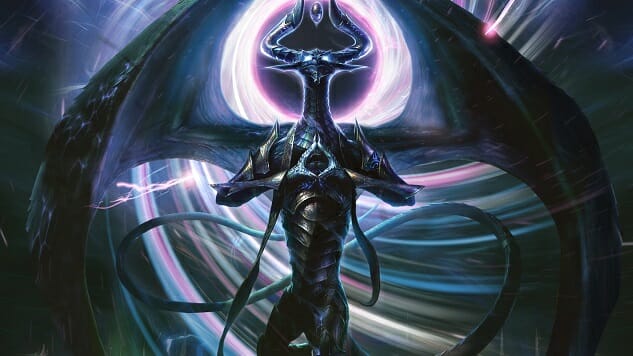Magic‘s The War of the Spark Is an All-Star Planeswalker Jam
Images courtesy of Wizards of the Coast Games Reviews Magic: The Gathering
War of the Spark, the newest set that’s out now for Magic: The Gathering, is a capstone for the past couple years of the game. 2015’s Magic Origins reconfigured some key characters from the game’s story, 2016’s Oath of the Gatewatch unified them into a superteam of multiverse-spanning wizard warriors, and now War of the Spark is putting them up against their biggest bad guy: the nefarious dragon Nicol Bolas. Narratively, it’s a big culminating moment, but the vast majority of most people’s time around Magic doesn’t have much to do with that splashy story. It has to do with physical and digital cards. War of the Spark tries to be as epic mechanically as it is narratively, and that’s where it stumbles for me.
The big pitch behind War of the Spark is that an evil, magical dragon has invaded Ravnica, one of the most popular planes (worlds) of Magic. He’s brought a zombie army, his own lackeys, and he’s activated a trap that will bring all of the planeswalkers (powerful wizard warriors) to the plane for one final battle. That shakes out in a very specific way in the design of this set versus others: there’s a planeswalker card in every pack.
A planeswalker in Magic is normally a special thing. There are generally less than five printed in each set of 260 cards or so, and if a player can cast a planeswalker and keep it in the game, they can generally win. That’s because planeswalkers are sort of pseudo-players in that they sit on the board, have an ability you can activate without paying any resources every turn, and generally have an “ultimate” ability that secures a game win. For example, if an opponent doesn’t interact with her, an unattended Liliana of the Veil will make them discard a card a turn until she makes them destroy half of their board. It’s brutal.
But since War of the Spark is centered on a war that is drawing many planeswalkers to one place, they’re everywhere. Instead of there being a few of them, there are 36 in the set, and they appear at the uncommon rarity on up. When you open up packs to play a Limited format, you will see a lot of them. When you go to build decks in Constructed, you will have a lot to choose from. A card type that was fairly rare and didn’t come up in deckbuilding considerations or combat math all that often is now a massive, integral part of the game in both formats.
The introduction of a mass number of planeswalkers to the Limited formats means that the game is more complex in two ways.
First, this set has different deckbuilding requirements. Because planeswalkers are everywhere and so powerful, you have to build decks in such a way that you can deal with a turn four or turn five ‘walker like Angrath, Captain of Chaos, who can plop down, start making a zombie army, and make it so much harder to block your enemy’s attacks. That means that previous slots in your deck that might have contained a couple more creatures need to contain whatever cards you have that can directly deal with planeswalkers. It’s a significant shift, even if it doesn’t seem like one in the abstract.
Second, it becomes more difficult to make decisions while actually playing the game. During the attack phase of a game of Magic, you have a choice to make if your opponent has a planeswalker on the battlefield. Do you attack your opponent to reduce their life closer to zero so you can win the game? Do you attack their planeswalkers to get a better advantage later on in the game? Do you try to close it out now or later? And this is a simple decision tree fork, but in a game with an extreme amount of complexity like Magic, this is a higher cognitive burden than most experienced players and the designers of the game are aware of.
I have had the same experience that Magic Pro Tour Historian Brian David Marshall tweeted about, which is that I have played several games on Magic Arena in which my opponent either quits or makes an objective tactical error in the face of multiple planeswalkers and a thick board state of creatures and enchantments. A normal game of Magic already asks players to keep up with a lot, and a set that triples down on complicated and cool cards also triples down on difficulty.
I’ve been playing Magic for more than ten years, and I love playing War of the Spark. As many people have said already, this set has cards that are extremely powerful, and it’s the closest feeling I have had to playing Cube, a format designed around playing with the most powerful cards in the game, in a set that is released in traditional booster boxes. For players with a lot of play experience and knowledge, War of the Spark is a massive accomplishment that they are going to get a lot of enjoyment out of.
But I also don’t think it would be worthwhile to try to introduce a new player to the game with this set. I couldn’t bring packs of this set to a tabletop afternoon with my friends who just sort of know the rules of Magic enough to play Commander every now and again. It’s a special set for longtime players, but it might be worth waiting for Magic 2020 over the summer if you’re looking to get new people interested or return to the game yourself.
Cameron Kunzelman tweets at @ckunzelman and writes about games at thiscageisworms.com. His latest game, Epanalepsis, is available on Steam.